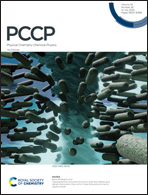Low-energy configurations of Pt6Cu6 clusters and their physical–chemical characterization: a high-accuracy DFT study
Abstract
Based on a combination of many-body potentials, an analysis of the inertia tensors and a Density Functional Theory framework, we use a method to harvest the lowest energy states of any set of cluster systems. Then, this methodology is applied to the Pt6Cu6 cluster case and the structural, chemical, electronic, anisotropy, magnetic and vibrational properties of the lowest energy isomers are studied. Unexpectedly, some tens of isomers with much lower energy than the precedent believed ground state [J. Chem. Phys., 131(4):044701] are found, which indicates the goodness of this methodology. Some of the isomers obtained present the point groups Cs, C2v according to Schoenflies notation, while others do not exhibit specific symmetry operations. The global chemical descriptors as the ionization potential, the electron affinity and the chemical hardness have oscillating behaviors with overall decreasing trends as the energy of the isomer grows up, indicating a higher rate of deactivation by sintering processes and a higher strength of the adsorption of small molecules on these systems. We present interesting results of the electronic, magnetic, anisotropy, vibrational and thermal properties of these clusters and discuss them; what can be useful information for future experiments and technical applications in varied fields as catalysis, spintronics, molecular magnetism or magnetic storage information.



 Please wait while we load your content...
Please wait while we load your content...